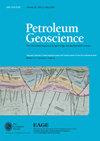利用人工智能工具预测碳酸盐的静态杨氏模量和无侧限抗压强度
IF 2.1
4区 地球科学
Q3 GEOSCIENCES, MULTIDISCIPLINARY
引用次数: 6
摘要
岩石弹性和破坏参数的准确估计在石油、土木和岩土工程应用中起着至关重要的作用。在钻井作业中,岩石弹性和破坏参数的连续测井被认为对优化地质力学地球模型非常有帮助。通常,岩石弹性和破坏参数是使用测井和经验相关性来估计的。这些是通过对岩芯样本进行的岩石力学实验室实验进行校准的。然而,由于这些样本获取成本高,测试耗时长,因此基于可用岩石物理测井(如体积密度、压缩波和剪切波传播时间)的人工智能(AI)模型被用于预测静态杨氏模量(Estatic)和无侧限抗压强度(UCS),重点是碳酸盐岩。在本研究中,我们提出了两种人工智能技术:人工神经网络(ANN)和自适应神经模糊推理系统(ANFIS)。本研究中使用的数据集包含从中东碳酸盐岩储层获得的120个数据点,我们从中开发了经验相关的ANN模型来预测Estatic,并开发了ANFIS模型来预测UCS。所提出的ANFIS模型预测的UCS与已发表的相关性之间的比较表明,ANFIS模型以较小的误差和较高的决定系数预测UCS。从ANFIS模型中获得的误差为4.5%,而在已发布的数据集上,其他相关性导致高达30%的误差。根据所获得的结果,我们可以说,所开发的模型将有助于地质力学工程师使用测井曲线预测Estatic和UCS,而无需在实验室中进行测量。专题收藏:本文是自然裂缝油藏收藏的一部分,可在以下网站获取:https://www.lyellcollection.org/cc/naturally-fractured-reservoirs本文章由计算机程序翻译,如有差异,请以英文原文为准。
A new look into the prediction of static Young's modulus and unconfined compressive strength of carbonate using artificial intelligence tools
Accurate estimation of rock elastic and failure parameters plays a vital role in petroleum, civil and geotechnical engineering applications. During drilling operations, continuous logs of rock elastic and failure parameters are considered very helpful in optimizing geomechanical earth models. Commonly, rock elastic and failure parameters are estimated using well logs and empirical correlations. These are calibrated with rock mechanics laboratory experiments conducted on core samples. However, since these samples are expensive to get and time-consuming to test, artificial intelligence (AI) models based on available petrophysical well logs such as bulk density, compressional wave and shear wave travel times are utilized to predict the static Young's modulus (Estatic) and the unconfined compressive strength (UCS) – with an emphasis on carbonate rocks. We present two AI techniques in this study: an artificial neural network (ANN) and an adaptive neuro-fuzzy inference system (ANFIS). The dataset used in this study contains 120 data points obtained from a Middle Eastern carbonate reservoir from which we develop an empirically correlated ANN model to predict Estatic and an ANFIS model to predict the UCS. A comparison between the UCS, predicted by the proposed ANFIS model, and the published correlations show that the ANFIS model predicted the UCS with less error and with a high coefficient of determination. The error obtained from the ANFIS model was 4.5%, while other correlations resulted in up to 30% error on a published dataset. On the basis of the results obtained, we can say that the developed models will help geomechanical engineers to predict Estatic and the UCS using well logs without the need to measure them in the laboratory. Thematic collection: This article is part of the Naturally Fractured Reservoirs collection available at: https://www.lyellcollection.org/cc/naturally-fractured-reservoirs
求助全文
通过发布文献求助,成功后即可免费获取论文全文。
去求助
来源期刊

Petroleum Geoscience
地学-地球科学综合
CiteScore
4.80
自引率
11.80%
发文量
28
审稿时长
>12 weeks
期刊介绍:
Petroleum Geoscience is the international journal of geoenergy and applied earth science, and is co-owned by the Geological Society of London and the European Association of Geoscientists and Engineers (EAGE).
Petroleum Geoscience transcends disciplinary boundaries and publishes a balanced mix of articles covering exploration, exploitation, appraisal, development and enhancement of sub-surface hydrocarbon resources and carbon repositories. The integration of disciplines in an applied context, whether for fluid production, carbon storage or related geoenergy applications, is a particular strength of the journal. Articles on enhancing exploration efficiency, lowering technological and environmental risk, and improving hydrocarbon recovery communicate the latest developments in sub-surface geoscience to a wide readership.
Petroleum Geoscience provides a multidisciplinary forum for those engaged in the science and technology of the rock-related sub-surface disciplines. The journal reaches some 8000 individual subscribers, and a further 1100 institutional subscriptions provide global access to readers including geologists, geophysicists, petroleum and reservoir engineers, petrophysicists and geochemists in both academia and industry. The journal aims to share knowledge of reservoir geoscience and to reflect the international nature of its development.
 求助内容:
求助内容: 应助结果提醒方式:
应助结果提醒方式:


